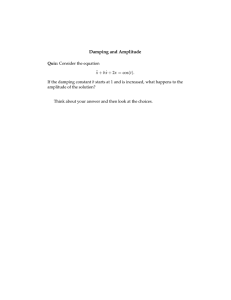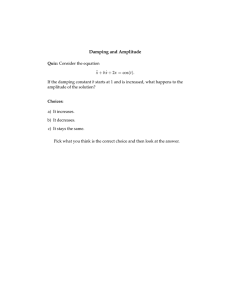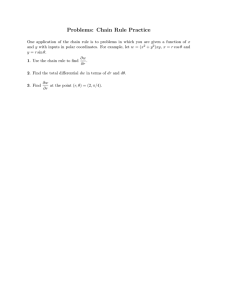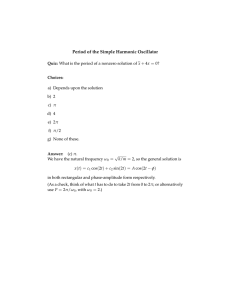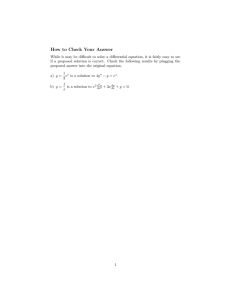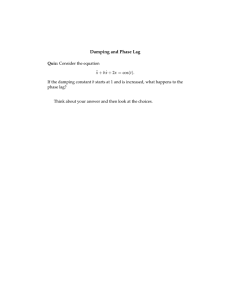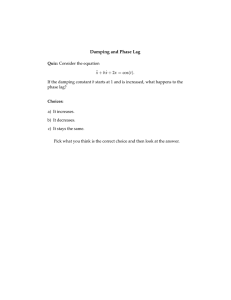Problem Set 2 - Internet Institute
advertisement
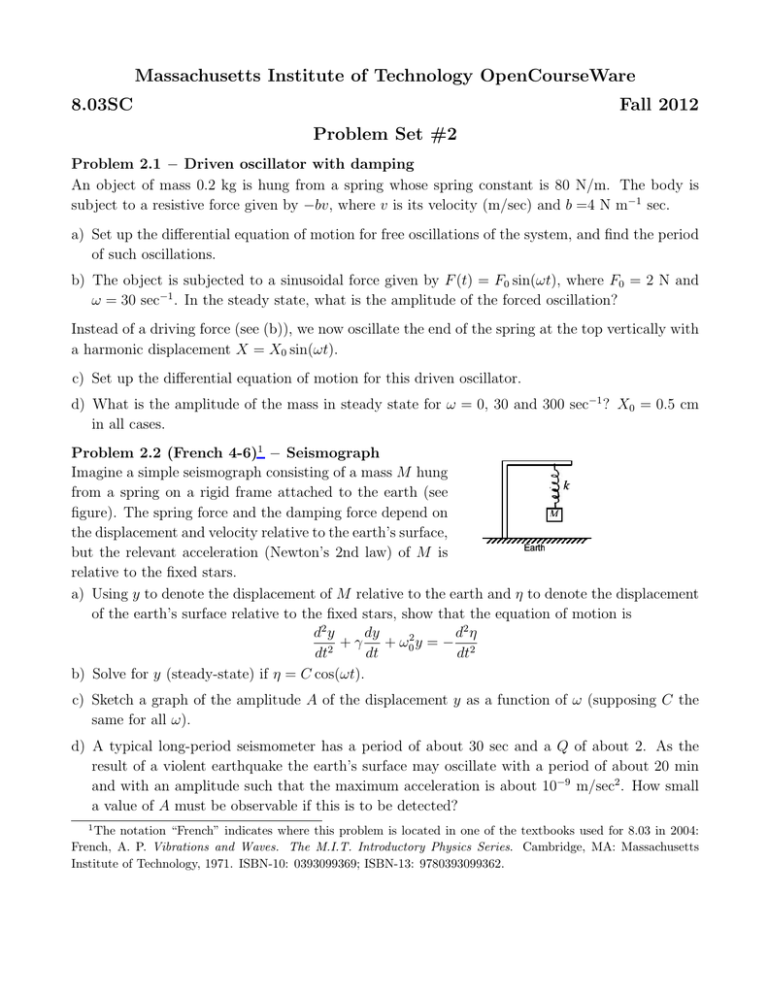
Massachusetts Institute of Technology OpenCourseWare 8.03SC Fall 2012 Problem Set #2 Problem 2.1 − Driven oscillator with damping An object of mass 0.2 kg is hung from a spring whose spring constant is 80 N/m. The body is subject to a resistive force given by −bv, where v is its velocity (m/sec) and b =4 N m−1 sec. a) Set up the differential equation of motion for free oscillations of the system, and find the period of such oscillations. b) The object is subjected to a sinusoidal force given by F (t) = F0 sin(ωt), where F0 = 2 N and ω = 30 sec−1 . In the steady state, what is the amplitude of the forced oscillation? Instead of a driving force (see (b)), we now oscillate the end of the spring at the top vertically with a harmonic displacement X = X0 sin(ωt). c) Set up the differential equation of motion for this driven oscillator. d) What is the amplitude of the mass in steady state for ω = 0, 30 and 300 sec−1 ? X0 = 0.5 cm in all cases. Problem 2.2 (French 4-6)1 − Seismograph Imagine a simple seismograph consisting of a mass M hung from a spring on a rigid frame attached to the earth (see figure). The spring force and the damping force depend on the displacement and velocity relative to the earth’s surface, but the relevant acceleration (Newton’s 2nd law) of M is relative to the fixed stars. a) Using y to denote the displacement of M relative to the earth and η to denote the displacement of the earth’s surface relative to the fixed stars, show that the equation of motion is d2 y dy d2 η 2 y = − + γ + ω 0 dt dt2 dt2 b) Solve for y (steady-state) if η = C cos(ωt). c) Sketch a graph of the amplitude A of the displacement y as a function of ω (supposing C the same for all ω). d) A typical long-period seismometer has a period of about 30 sec and a Q of about 2. As the result of a violent earthquake the earth’s surface may oscillate with a period of about 20 min and with an amplitude such that the maximum acceleration is about 10−9 m/sec2 . How small a value of A must be observable if this is to be detected? 1 The notation “French” indicates where this problem is located in one of the textbooks used for 8.03 in 2004: French, A. P. Vibrations and Waves. The M.I.T. Introductory Physics Series. Cambridge, MA: Massachusetts Institute of Technology, 1971. ISBN-10: 0393099369; ISBN-13: 9780393099362. e) Make sure you appreciate the big difference between this problem and problem 2.1. Compare the amplitudes of the two problems at very low and very high frequencies. Problem 2.3 (French 4-10)− Power dissipation The power input to maintain forced vibrations can be calculated by recognizing that this power is the mean rate of doing work against the resistive force −bv. a) Satisfy yourself that the instantaneous rate of doing work against this force is equal to bv 2 . b) Using x = A cos(ωt − δ), show that the mean rate of doing work is bω 2 A2 /2. c) Substitute the value of A at any arbitrary frequency and hence obtain the expression for P¯ . The result will be the same as given in Eq. (4-23) on page 98 in French. Problem 2.4 − Transient behavior Consider the simple damped spring-mass system shown in the first figure. The mass is driven by an external force given by F (t) = F0 cos(ωt + φ). The mass is at rest at its equilibrium position, x = 0, when the force is turned on instantaneously at t = 0. The re­ sponse of the mass to this driving force in shown in the second figure. Assuming that the mass is m = 1 kg, use the time series for x(t) to get estimates (within 20%) for: 8 b) The damping coefficient, b in N s/m. c) The frequency of the driving force, ω/(2π) in Hz. d) The amplitude of the driving force, F0 in N. e) What is φ? MIT OCW 8.03SC 6 4 2 Displacement (m) a) The natural frequency of the undamped oscillator, ω0 /(2π) in Hz. Hint: You may assume that γ is small, so that ω1 ≡ ω02 − γ 2 /4 ≈ ω0 . 0 ï2 ï4 ï6 ï8 ï10 ï12 0 5 2 10 Time (s) 15 20 Problem Set #2 Problem 2.5 − Driven RLC circuit A generator of emf V (t) = V0 cos(ωt) is connected in series with a resistance R, an inductance L, and a capacitance C. a) Using Faraday’s law, write down the differential equations for the current I in the circuit and for the charge, q, on the capacitor. b) Solve for q(ω, t). c) Solve for I(ω, t). In what follows, V0 = 3 V, R = 50 Ω, L = 100 mH, and C = 0.01 µF. d) Plot the amplitude of the current (Io ) as a function of ω. e) At what value of ω is (Io ) a maximum? f) Plot qo as a function of ω. g) At what frequency, ω, is the voltage across the capacitor a maximum? MIT OCW 8.03SC 3 Problem Set #2 MIT OpenCourseWare http://ocw.mit.edu 8.03SC Physics III: Vibrations and Waves Fall 2012 For information about citing these materials or our Terms of Use, visit: http://ocw.mit.edu/terms.
